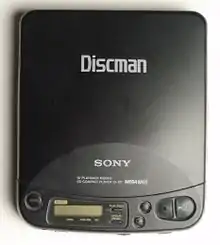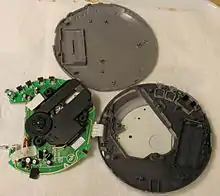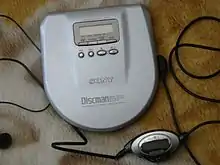

.jpg.webp)
A portable CD player is a portable audio player used to play compact discs. The first audio player released was the Discman D-50 by Sony.[1]
Features

The basic features of a portable CD player are:
- Play/Pause button
- Stop button
- Rewind button
- Fast forward button
- Hold button (some models)
- Liquid crystal display
- Headphone/Audio out socket
The play/pause button allows the user to pause in the middle of a track (song) and resume play where the listener left off by pressing the button again. The stop button stops playing. The fast forward and rewind buttons can be held down to move rapidly forward (fast forward) or backward (rewind) in a track; play will resume once the button is preleased. The liquid crystal display provides a visual indicator of remaining battery life, currently playing track number, and the amount of time elapsed on the track. Some portable CD players can play CD-R/CD-RW discs and some can play other formats such as MP3-encoded audio. While audio typically is output via a headphone connector, higher-end models may feature an additional integrated speaker.
The 8 cm CD provides a smaller alternative to the normal 12 cm CD (although with a lower capacity). Miniature players exist that play only this format.
Some portable CD players feature an externally attached playback controller as depicted, to facilitate control while the main unit is placed in a bag or pocket.
Issues with recordable CDs
Some early portable CD players do not play recordable CDs (CD-R, CD-RW) properly due to the significantly lower reflectivity of CD-RW.
A consumer-recorded CD is recorded by making marks in a thin layer of organic dye, which leads to incompatibility with some CD players. For some users of CD-Rs, the solution to this is to burn the CD at a slower speed or use a different brand of recordable CDs. Burning at too slow a speed can also cause issues. Ideally, CD-Rs should be burned at half their rated maximum speed, for example, a CD-R with a maximum rating of 48x should be burned at 24x.
See also
References
- ↑ Lungu, R. "History of the Portable Audio Player." Archived 2012-05-02 at the Wayback Machine 2008-11-27.